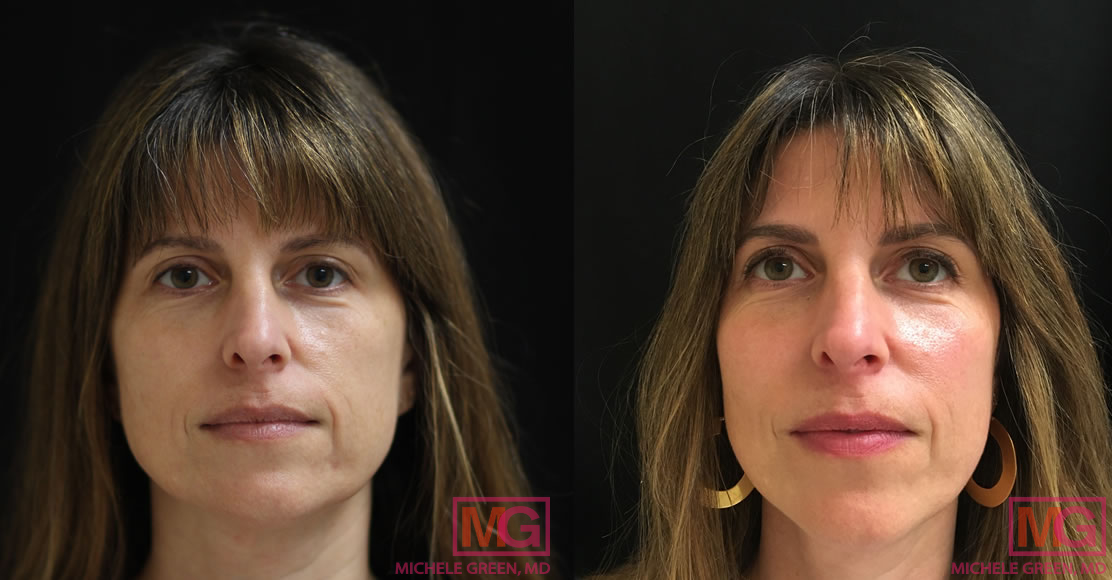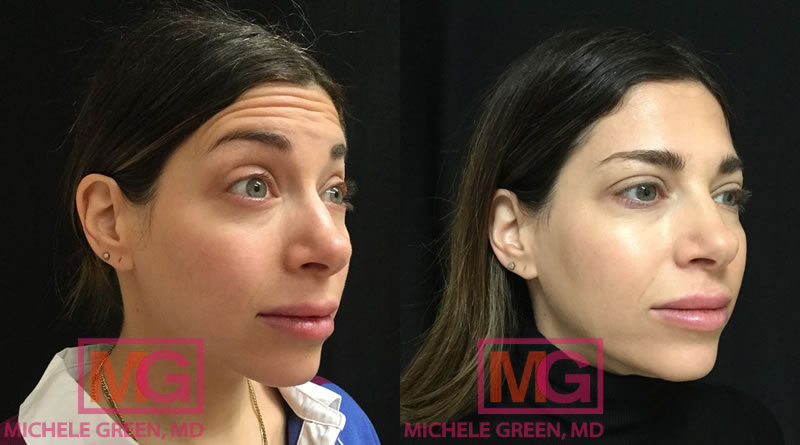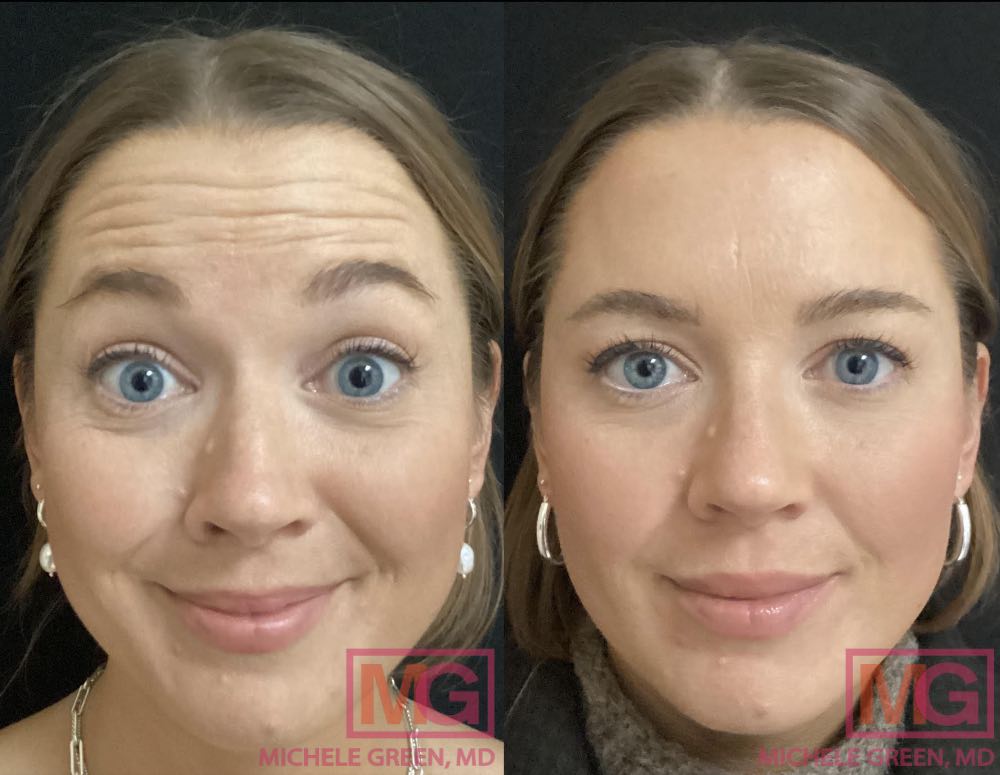Dysport vs Juvederm
Over time, signs of aging begin to show on the skin. The production of structural proteins, collagen and elastin, begins to decrease leading to the appearance of wrinkles and fine lines, creases, volume loss, and thinning lips. Repeated facial muscle contractions over the years can contribute to the formation of frown lines (glabellar lines) between the eyebrows, forehead lines, crow’s feet at the corners of the eyes, nasolabial folds, and marionette lines. These indicators of the natural aging process can make patients feel self-conscious as they look for a way to restore a naturally youthful appearance to the face. Many may falsely believe that the only way to erase facial wrinkles and achieve smooth, youthful-looking skin is via a surgical facelift performed by a plastic surgeon. However, there are many non-surgical cosmetic treatments available at board-certified dermatologist, Dr. Michele Green’s, office that require no downtime and achieve excellent results. Dr. Green offers a wide range of cosmetic injections for full facial rejuvenation with two of the most popular being the dermal filler, Juvederm, and the botulinum toxin type A injection, Dysport.
Juvederm and Dysport are two FDA-approved cosmetic procedures that work to erase wrinkles and provide smooth, youthful-looking skin, that are available at expert injector, Dr. Green’s, New York City dermatology office. While both treatments involve an injection and can be used to erase facial wrinkles, they work differently and are used for different treatment areas. Juvederm is a hyaluronic acid facial filler that is injected in the mid to deep dermal layers of the skin to add volume to the treatment area and fill in mild to severe facial lines and creases, while also hydrating the skin. Dysport injections are comprised of a neurotoxin that is injected into the muscle to inhibit muscle movement, smooth out the skin at the treatment area, and keep dynamic wrinkles from becoming etched into the skin. Due to their different uses for facial rejuvenation, Dr. Green will often pair the two together for a full liquid facelift, which requires no downtime, making it an excellent alternative to plastic surgery.
Expert, board-certified dermatologist, Dr. Michele Green, has been treating patients at her Upper East Side New York City office for more than 25 years. Known for her less-is-more approach to injectable treatments, Dr. Green is highly adept at creating natural-looking, smooth, and youthful skin. Dr. Green is experienced in uses a wide range of skin care products and cosmetic procedures, including neuromodulators such as Dysport, Botox, Xeomin, and Jeuveau, and dermal fillers, such as Juvederm, Restylane, Radiesse, and Sculptra. Highly regarded for high patient satisfaction, Dr. Green has been repeatedly voted as one of the best healthcare providers in New York City by such publications as Castle Connelly, Super Doctors, and New York Magazine.

What is Dysport?
Dysport is one of four neuromodulators available on the market for cosmetic use, along with Botox cosmetic, Xeomin, and Jeuveau, and is comprised of the active ingredient abobotulinumtoxinA. First FDA-approved in 2009, Dysport can be used to treat a variety of cosmetic and medical concerns, including severe frown lines, crow’s feet around the eyes, forehead lines, spasticity, and cervical dystonia. Similar to Botox injections, Dysport works to essentially “freeze” the muscle at the injection site by blocking the nerve signals that tell the muscles there to contract. As we age, creases caused by dynamic muscles, which are the muscles responsible for facial expressions, become etched into the skin as production of the structural proteins, collagen and elastin, decreases. By injecting a neurotoxin, such as Dysport, into the muscle, it prevents the muscle from contracting and causes the muscle to relax. This smooths out the facial wrinkles found in the treatment area, creating a more youthful appearance.
What is Juvederm?
Juvederm fillers are a type of hyaluronic acid filler, which can be used to reverse signs of the natural aging process by restoring lost volume, and erasing fine lines and wrinkles. First FDA approved in 2006 for the treatment of moderate to severe smile lines and nasolabial folds, Juvederm is created by the company Allergan, the same company responsible for the production of Botox treatments. The Juvederm portfolio of dermal fillers can be used in many treatment areas to address a range of concerns, including the midface to restore age-related volume loss, the chin and jawline for contouring, the lips for enhancement and erasing perioral lines, under the eyes to fill in hollows, and around the mouth to address moderate to severe creases. The key ingredient of Juvederm fillers is hyaluronic acid, which is a naturally occurring substance in the body that helps to keep the skin hydrated and smooth. Dermal fillers, such as Juvederm, are injected into the dermal layer of skin to add volume, fill in fine lines and wrinkles, and hydrate the skin.
What is Dysport used for?
Dysport injectable treatment can be used for a range of cosmetic and medical purposes. Cosmetically, Dysport is currently FDA-approved to erase the moderate to severe frown lines that can appear between the eyebrows that are also known as “glabellar lines.” These creases can appear when you furrow your brow in frustration or concentration. Additionally, Dysport can be used to erase crow’s feet wrinkles, which extend outwards from the corners of the eyes like a fan and appear when you squint or smile. Forehead lines, or the horizontal lines that appear on the forehead when you raise your eyebrows, can also be erased with the help of Dysport injections. There are also off-label uses for Dysport, meaning they work but are not yet FDA-approved, including correcting brow symmetry, addressing a gummy smile, along the jawline for facial slimming, and for upper lip lines.
Dysport is also FDA-approved to treat several medical conditions, including spasticity, which is a condition characterized by muscle spasms or abnormal tightness that occurs due to damaged nerve cells, and cervical dystonia, which is caused by involuntary and painful neck spasms. When Dysport is injected into the muscle responsible for these spasms, it can help to mitigate the symptoms of both conditions, resulting in less pain and discomfort.
What is Juvederm used for?
There are many different types of Juvederm fillers available that are specifically formulated to address a variety of different treatment areas and cosmetic concerns, including:
Juvederm Ultra XC – The first Juvederm filler to be FDA approved, Juvederm Ultra XC works well to address mild to moderate marionette lines and nasolabial folds. Juvederm Ultra XC can also be used in the lips for increased lip enhancement and fullness.
Juvederm Ultra Plus – Comprised of a thicker gel than Juvederm Ultra, Juvederm Ultra Plus is used to address moderate to severe marionette lines and nasolabial folds. Ultra Plus can also be used for lip filler for a more dramatic enhancement.
Juvederm Voluma – Designed specifically to address age-related volume loss in the midface, Juvederm Voluma restores lost volume in the cheeks and chin. Juvederm Voluma works to fill in hollows that give the cheeks a gaunt appearance and can work for chin augmentation to improve the jawline.
Juvederm Vollure – Juvederm Vollure is best used to address the smile lines around the mouth to help correct moderate to severe facial wrinkles. Juvederm Vollure is particularly long lasting among the Juvederm family of fillers, with results remaining for up to 18 months.
Juvederm Volbella – Juvederm Volbella was formulated specifically for the lips and to address vertical lip lines surrounding the mouth. With a smaller particle size, Juvederm Volbella is great for natural-looking lip enhancements, filling in perioral lines, and for filling in hollows in the delicate under-eye area.
Juvederm Vollux – The newest member of the Juvederm family, Juvederm Vollux has been created to specifically enhance the jawline. The filler works to adjust the proportions of the jawline for the ideal facial contour.
What’s the difference between Dysport and a filler, such as Juvederm?
The main difference between Dysport and a dermal filler, such as Juvederm, is where they are injected and how they function to erase fine lines, wrinkles, and creases. Neuromodulators, such as Dysport, are injected directly into the muscle responsible for the dynamic wrinkles in the area, which works to keep the muscle from contracting. As a result, the muscle can no longer contract, which smoothes away the wrinkles in the area for as long as the treatment lasts. Juvederm, on the other hand, is injected under the skin with the intension of adding volume to the treatment area, which works to fill in fine lines and wrinkles. Juvederm also works to fill in hollows in the cheeks and under the eyes as well as to contour the jawline by creating symmetry and correcting a receding chin. As Dysport and Juvederm work very differently and are injected into different areas of the face, Dr. Green will often pair the two treatments together in order to achieve in better results.

Is Dysport a filler?
Both Juvederm dermal fillers and Dysport involve injections as a part of the cosmetic procedure, however, Dysport is not a filler treatment. Dermal fillers work with an active ingredient, such as hyaluronic acid or poly-L-lactic acid, to add volume to the treatment area and fill in wrinkles and creases. The active ingredient in Dysport is the neurotoxin botulinum toxin type A, which inhibits the contraction of facial muscles when injected. For that reason, Dysport and dermal fillers, such as Juvederm, cannot be used in the same way, and are in fact used to combat aging in a different but complementary way.
Which is better, Dysport or Juvederm?
Both Juvederm filler and Dysport injections work to combat the natural aging process by erasing fine lines and wrinkles on the face and neither is inherently “better” than the other – they simply work in different ways. Dysport works by being injected directly into the muscle to erase and prevent the further formation of dynamic wrinkles, such as forehead lines, glabellar lines, smile lines, and crow’s feet. Juvederm is injected into the dermis to add volume and hydration to the treatment area to address marionette lines, nasolabial folds, volume loss in the midface, a lack of symmetry in the jawline, receding chin, and thinning lips. When you have your initial consultation with Dr. Green, she will help you to determine which treatment is best to meet your needs.
Which lasts longer Dysport or Juvederm?
Both Juvederm and Dysport are temporary cosmetic treatments, meaning that over time, the effects of the treatment will wear off and maintenance appointments are required in order to maintain the results. While neither treatment is permanent, Juvederm is a longer lasting treatment than Dysport. The results of Dysport injections will last for between three and six months before a maintenance appointment is required, while the results of Juvederm fillers will be visible for between 12 and 18 months, depending on the type of Juvederm filler that is used. Dr. Green typically recommends scheduling a Dysport touch up appointment every 3-4 months for continued results and a Juvederm touch up once a year.
Are Dysport and Botox the same?
There are many similarities between Botox and Dysport but they are not completely the same. Both Botox and Dysport are neuromodulators that contain botulinum toxin type A, though Botox contains onabotulinumtoxinA while Dysport contains abobotulinumtoxinA. While the exact botulinum toxin contained in each differs, they work in much the same way to “freeze” the muscle by preventing muscle contraction in the treatment area. Both Dysport and Botox provide results for 3-4 months and can be repeated for continued results over time. The main difference between the two is the concentration of trace proteins in the injectable solution, which affects how soon patients will be able to see the results of the treatment. With Dysport injections, the effects of the treatment can be seen within 2-4 days of receiving the treatment, whereas Botox effects can be seen within one to two weeks. Botox and Dysport are also FDA-approved to treat many of the same conditions but not all. Similarly to Botox, Dysport is FDA-approved to treat forehead lines, crow’s feet, frown lines, and cervical dystonia, however, Botox is also approved to treat chronic migraines, overactive bladder, hyperhidrosis, and blepharospasm.
Why Dysport over Botox?
Both Dysport and Botox can be used for similar purposes cosmetically and medically – so how do you know which one to choose? When you have your initial consultation with expert, board-certified dermatologist, Dr. Green, you will discuss you aesthetic goals and treatment needs and she will help you to determine the treatment option that will work best for you. When it comes to deciding between Dysport and Botox, and advantage of Dysport over Botox is that the results of the cosmetic procedure can be seen much sooner due to the composition of the injection. Dysport can also diffuse to a larger area than Botox. Neither cosmetic treatment is inherently “better” than the other, rather, it is about determining what will work best for you.
Can Dysport be used on lips?
Dysport injections are used to smooth out dynamic wrinkles that appear on the forehead, between the eyebrows, and at the corners of the eyes. These wrinkles are caused by repeated contraction of facial muscles, which cause the fine lines formed to become etched into the skin and Dysport is used to inhibit the muscles from contracting. As a result, Dysport is not the treatment that is used for lip enhancement, rather Dr. Green recommends the use of Juvederm Ultra Plus or Juvederm Vollure.
What are the side effects of Dysport?
Dysport is a safe and effective treatment for dynamic wrinkles, particularly when performed by an expert injector, such as Dr. Green. Like any injectable treatment, there are common, mild side effects of Dysport, which include swelling, redness, and possible bruising at the injection site. These side effects will typically resolve after several days on their own. Dr. Green recommends refraining from blood thinners, such as Ibuprofen, in the days before and after the treatment, as blood thinners can make bruising worse. When seeking Dysport injections from a less experienced injector, there are risks for more serious side effects, which can include difficulty swallowing, respiratory tract injections, loss of bladder control, muscle weakness, flu-like symptoms, and possible toxin spread. The risk of serious side effects greatly decreases when you seek treatment from a board certified dermatologist, such as Dr. Green.

What is the difference between Juvederm and Restylane?
Similarly to Juvederm, Restylane is a hyaluronic acid filler that works to restore volume, erase fine lines and wrinkles, and contour a variety of areas on the face and body. Like Dysport, Restylane is produced by the cosmetic company Galderma, and has a wide portfolio of different dermal fillers that vary in composition and particle size to address different areas of the face and body. While both Juvederm and Restylane are hyaluronic acid fillers, meaning they both have the active ingredient of hyaluronic acid, they differ in the cross-linking technology used to add volume and structure to the filler gel. Both Restylane and Juvederm are highly effective and Dr. Green has both families of fillers available at her office.
What is the difference between Juvederm and Sculptra?
While Juvederm and Restylane are both hyaluronic acid fillers, Sculptra differs from both in that the key ingredient is poly-L-lactic acid. Sculptra is a synthetic filler that is biodegradable and was FDA-approved in 2009 for the treatment of facial hollows. The poly-L-lactic acid active ingredient promotes collagenasis, which is the production of collagen, to help give the skin structure and volume. Thus, even when the filler dissolves from the treatment area, the production of collagen continues and results continue to improve over time as the body’s natural collagen production process is stimulated.
How to choose between Juvederm and Dysport and start treatment today
When it comes to choosing between Juvederm and Dysport, luckily, you don’t have to! Juvederm and Dysport are both used to erase fine lines and wrinkles and combat other signs of aging, however, they work very differently and are injected into different areas of the face and body. Juvederm can be used to combat volume loss, fill in facial hollows, and enhance the jawline, while Dysport can be used to freeze the dynamic muscles responsible for creases that occur as a result of repeated facial expressions such as smiling, squinting, frowning, furrowing your brow, or raising your eyebrows. Dr. Green will examine the treatment area and determine which treatment plan is right for you, whether that includes Juvederm, Dysport or both. To find out more, contact us online or at 212 535 3088 to arrange an appointment.
 212-535-3088
212-535-3088